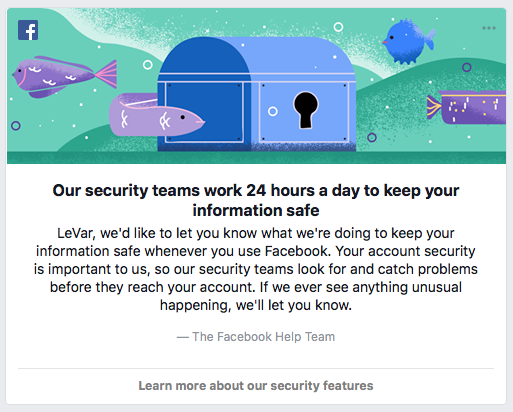Cyber News Rundown: A Wild Thanatos Appears!
The Cyber News Rundown brings you the latest happenings in cybersecurity news weekly. Who am I? I’m Connor Madsen, a Webroot Threat Research Analyst and a guy with a passion for all things security. Any questions? Just ask.
Thanatos Ransomware Causing Major Damage for Victims
A new ransomware variant has recently appeared and is proving to be more troublesome than most that came before it. By using individual encryption keys for each file, which it does not save, decryption is nearly impossible, even after paying the relatively small ransom of $200. Thanatos is also the first ransomware to accept Bitcoin Cash as a payment method.
Cryptojacking Found on LA Times Site
Researchers have stumbled onto yet another unsecured Amazon AWS server running a cryptominer. This time, the LA Times’ Homicide Report is at fault. Initially, the researchers found that the widely-accessible server had public write access turned on, which they reported to the server’s owner. Unfortunately, the researchers weren’t the first to find the server, which is how the Monero miner was placed on a single, moderately trafficked site within the LA Times network.
UK School CCTV Feeds Popping Up on US Websites
Recently, surveillance videos from several UK schools made their way onto a US-based website that hosts unsecured camera footage from around the world. While the footage was mainly from the exterior of the schools, it still causes concern over the safety and privacy of the students the cameras are meant to protect. While the breach can be traced back to the camera manufacturers, who did not implement strong device security, responsibility also falls on the staff who set up the cameras in the first place. This news serves as a reminder to always take cybersecurity precautions and change manufacturer default settings.
Cryptocurrency Miner Packed with Annoying Adware
A new cryptocurrency miner named UpdateChecker has been making the rounds over the last few days. The program is distributed as a fake Flash Player update and comes with the bonus of ads that run at hour-long intervals. The malware itself is downloaded from fake Adobe update websites and will immediately begin optimizing itself for the local machine and checking for updates to its own files. Unfortunately for victims of UpdateChecker, it is rather troublesome to remove, as it will relaunch itself if you kill the process, and can restart the miner anytime you shut it off.
Apple Repair Center Generating Excessive Emergency Calls
Since late last year, emergency dispatchers and police departments in Sacramento County, California have received over 1,600 calls originating from a local Apple repair facility. The calls are likely from one of two devices Apple manufactures that can make emergency calls without a SIM card or service provider. While this isn’t the first case of Apple devices triggering hundreds of emergency calls, the company is working with local law enforcement agencies to find a resolution.
Security Awareness Training: How to Get Started
In the past, security awareness training for user education—i.e. empowering users to make more savvy IT decisions in their daily routines—was considered a “nice to have,” not a necessity. The decision to adopt user education was typically passed over because of budget, lack of in-house expertise, and the general lack of availability of high-quality, low-cost, computer-based training. In particular, small- to medium-sized businesses (SMBs) have suffered from these types of constraints, compared to larger, more resource rich organizations.
Today, it’s clear that end user education isn’t just “nice to have,” and SMBs know it. As recently as August of 2017, a Better Business Bureau study on the State of Cybersecurity revealed that almost half of SMBs with 50 employees and under regard security awareness training among their top 3 security expenditures, alongside firewalls and endpoint protection.
The increase in interest and budget allocation for end user education is understandable. On average, SMBs face $80,000 in annual losses following a ransomware or data loss breach. Users are on the front lines of your business, and even the most advanced security can’t stop them from willingly, if unwittingly, handing over sensitive access credentials. If you’re not educating your users, then you are putting your organization at an unnecessary and costly risk.
Getting your end user education program started
Introduce to Stakeholders
Like any new program, building a foundation for success begins when you engage your stakeholders and management teams. Send an email explaining the value of security awareness to management, share details and reports around your first phishing and training campaigns, and loop in IT. Not sure how to craft that first email? Check out Webroot’s Security Awareness Training for help and templates to get you started.
Start out with a Phishing Campaign
Consider starting your security awareness program with a simulated phishing campaign. The results of the simulation can also be used to demonstrate value to any more skeptical or reluctant IT decision-makers. Use the first phishing campaign as your baseline to gauge the level of awareness your end users already have. Webroot Security Awareness Training comes with a variety of template options to help you get started. We recommend using a template that mimics an internal communication from HR or the IT department to get the most eyes on the email. For early campaigns, it’s also a good idea to use Webroot’s “404 Page Note Found” template so users who fall for the phishing lure are unaware. This will help keep water cooler talk at a minimum, giving you a more accurate baseline. After that, be sure to link your phishing campaigns to training pages and courses to maximize the training opportunity.
Share results with End Users
Use feedback to inspire smarter habits. A key objective for security awareness training is to engage end users and raise the level of cyber awareness throughout the organization. For instance, sharing results of a simulated phishing campaign can help employees understand the impact of poor online habits and motivate them to practice better behaviors.
Webroot Security Awareness Training lets admins see who clicked what in a phishing simulation. Bear in mind: the point of sharing results is not to shame the unwitting marks who fell for the scam. Instead, try capitalizing on everyone’s engagement by sharing an overall statistical report, so users can recognize whether they clicked or avoided the phishing lure, without fear of embarrassment. More importantly, such a report would show the statistics around the organization as a whole, opening the door for further training programs to fill security gaps and provide a continuous learning experience.
Continuous Training: Set up your phishing and training program
Once end users are engaged and understand the value, the next step is setting up a training program. There is no one-size-fits-all program, but we recommend running at least one to two phishing campaigns per month and a minimum of one to two training courses per quarter. Depending on the needs of each organization, you may want to increase the frequency and adjust intervals throughout the year. Webroot Security Awareness Training includes numerous pre-built phishing templates you can use, including real-world phishing scenarios (defanged from the wild.) It also offers professionally developed and engaging topical training courses, which you can be proud to share with your company. Courses range from cybersecurity best practices and 5-minute micro-learning courses to in-depth compliance courses on PCI, HIPAA, GDPR, SEC/FINRA, and more.
When you start seeing the significant impact that relevant, high-quality, and proven security awareness education has on your employees, you’ll wonder how your business ever managed without it.
Cyber News Rundown: Linux OS Hacked onto Nintendo Switch
The Cyber News Rundown brings you the latest happenings in cybersecurity news weekly. Who am I? I’m Connor Madsen, a Webroot Threat Research Analyst and a guy with a passion for all things security. Any questions? Just ask.
Hackers Run Linux OS On Nintendo Switch
When gaming consoles get hacked, it’s usually by someone who wants to play pirated games. Not this time. Recently, a group of hackers found an exploit that allowed them to deploy a full Linux OS onto the Nintendo Switch. The flaw is contained within the specific Tegra X1 chips used by the Switch for core functionality. These are not easily patched and would likely require a recall if the flaw becomes a major problem.
California Employee Data Breach
Employees working in the Department of Fish and Wildlife for California were recently notified that their Social Security numbers had been exposed in a data breach from late last year. The breach appears to have stemmed from a former employee downloading the data and removing it from the premises, prior to having left the company. This type of breach is extremely common, as many companies don’t enforce more strict data policies for current and former employees.
Facebook Bug Spams Users With 2FA System
In the last week or so, several Facebook users have taken to other social media platforms to announce a nearly endless stream of spam being sent to the phone numbers they had used for 2-factor authentication. The spam then began posting the user’s replies to their Facebook wall, even after multiple attempts to stop the messages. While Facebook has since resolved the issue, they have remained vague about when they’ll finally discontinue the program functionality that caused the issue in the first place.
Crypto-miners Found on Tesla Servers
Following the breach of Tesla’s cloud server last year, company engineers have been discovering cryptocurrency miners on several of their internal servers. The initial breach occurred because their Kubernetes console lacked a password, and, once in, the hackers set up a complex mining operation that used multiple techniques to avoid detection.
FedEx Breach Exposes Personal Information
Over the last few days, officials have confirmed that over 119,000 individual forms of scanned identification belonging to Bongo International, an international sales broker that was bought by FedEx in 2014, were left exposed to the public. The data, which was found on an Amazon S3 server, was likely forgotten about amidst the acquisition and was available for an unknown amount of time.
Malvertising: Avoid Bad Ad Invasion
The way people shop has changed drastically over the last 10 years. E-commerce continues to boom. In fact, 80% of Americans made an online purchase in the past month, according to the Omni-Channel Retail Report from BigEcommerce. Because what’s not to love about shopping online, receiving your items in just two days, and not having to put pants on?
Not surprisingly, the increase in online shopping has been accompanied by a spike in online advertisements. And in recent years, thanks to malvertising, things like display ads and social media promotions have gone from annoying to dangerous.
A Threatening Combination
The term malvertising is a merger of two words, malicious and advertising. It is defined as the use of online advertising as a vehicle to spread malware.
Malverts are created when cyber criminals embed malware-laden or malicious code into normal-looking online ads like pop-ups (fake browser updates, anti-virus programs, etc.), paid ads using Google AdWords, display ads, drive-by downloads, in-text or in-content advertising, and more.
These ads are then placed on the pages of legitimate websites — such as The New York Times, the BBC, MSN, and AOL, to name a few—by an agency or an automated ad server. Infections are then very difficult to avoid when you visit a site running malverts. In fact, users don’t even have to click on anything to have their device compromised. Sometimes, all it takes is loading the page.
Online Wolves in Sheep’s Clothing
To understand how malvertising sneaks onto sites, you first have to understand how online ads are placed. Many large, popular websites use third-party vendors or software called an ad server to find the ad that will make the site the most money. To get an ad on a vendor’s network, oftentimes all you need to do is sign up and submit. Because of this, many cybercriminals will submit clean advertising to ad networks for weeks to gain legitimacy and circulation, and ultimately get their work through the system. Once they do, they quickly switch out their ads for malverts. These booby-trapped ads are usually only active for a few hours before the attackers switch back to legitimate ones.
Since ad servers typically don’t have strict vetting processes or are automated, it’s relatively easy for attackers to slip malverts through without anyone knowing. In fact, the cyber security firm Confiant reported that some attackers, like the Zirconium group, set up 28 fake ad agencies in 2017 through which to create and submit their malverts.
What’s more, these third-party networks often display different ads on the same page, meaning two people could visit the site and only one would be infected — again making malverts even harder to track down and stop.
Defend your devices from malvertising
Even though large, sophisticated malware campaigns were mounted in 2017, there are #cybersmart ways to protect yourself against an attack in the year to come:
- Use an ad-blocker. Ad-blockers remove all online advertising, significantly reducing malvertising’s effects on the user. There have been cases of sophisticated malverts bypassing ad-blockers, but using one is still a great place to start.
- Keep your devices updated and secure. Make sure your operating system and plugins are updated, keep software patched, only run the latest browsers, and invest in a good anti-virus or malware detection program.
- Lock down your Java and Flash settings. Enable click-to-play plugin settings on your browser configuration for Java and Flash, which makes you give your device permission before running those plugins. Or disable Java and Flash altogether. You probably won’t miss them.
- Stay on top of WordPress. WordPress continues to be one of the most popular targets for hackers. The plugins have been exploited and abused the same way as Adobe, Flash, Java, and Silverlight have. If you use WordPress, protect yourself by keeping your website up to date, updating themes and plugins to the patched versions, and staying aware of the latest WordPress-related vulnerabilities.
- Practice safe browsing. Since malvertising can affect you even if you’re staying on legitimate sites (i.e. not trying to buy a kidney on the darknet), using safe browsing practices can greatly decrease your risk. Set up browser plugins to increase security and privacy, keep browsers and applications up-to-date, regularly check which plugins are being used and disable unnecessary ones, scan files before downloading, and watch out for phishing attacks.
And of course, using a reliable internet security product is the best way to protect yourself from cybercriminals. For extra credit, here are a few more general tips to protecting your devices.
- Skip public WiFi networks
- Pay with credit cards over debit cards online when possible
- Deactivate Bluetooth in public settings
- Always back up your files
Cyber News Rundown: Malware Attack Targets 2018 Winter Olympics
The Cyber News Rundown brings you the latest happenings in cybersecurity news weekly. Who am I? I’m Connor Madsen, a Webroot Threat Research Analyst and a guy with a passion for all things security. Any questions? Just ask.
Winter Olympics Disrupted by Malware Attack
The Winter Olympics are in full swing, and cybercriminals seem to be working just as hard as the athletes. Their nefarious minds are focused on distributing malware that targets several internal WiFi and television systems. In addition to a delay during the opening ceremonies, the malware caused major damage to the networks by wiping non-critical network files and using stolen credentials to traverse the networks with ease. With plenty of international information on hand, it’s surprising the attack focused more on destruction over data collection.
Cryptocurrency Scams from Celebrities on Twitter
At least two dozen fake Twitter accounts impersonating celebrities, and others closely tied to cryptocurrencies, have been promising to distribute various currencies to followers. These accounts are all very similar to the real celebrities’ user accounts, barring small spelling changes, and can be found commenting amongst their target’s posts. Although Twitter appears to be working swiftly to remove these types of accounts, more continue to appear.
News Site Offers Compromise to Disabling Ad-Blockers
With the increasing popularity of cryptojacking—the process of using cryptomining scripts on highly-trafficked sites to generate revenue—Salon.com is now offering a choice to visitors: disable your ad blocker or let them use your CPU for cryptomining. While this new offering may seem unusual, it’s likely to become more prevalent, since many sites depend on ad revenue to remain operational. The logic is that most users would prefer to allow mining scripts to run over being subjected to ads.
Telegram Leaves Zero-Day Bug Unfixed for Months
Researchers discovered a vulnerability within the Telegram messenger client that would allow attackers to send malware by using a specific character to mask the actual file without making any additional changes to it. This method can be used to fully commandeer a system by sending victims a simple downloader over SMS. The downloader deploys a variety of malicious tools onto the system itself. Telegram has since resolved documented issues, which appear to have targeted mainly Russian victims from as long ago as March 2017.
Canadian Telecom Firm Faces Security Flaw
A hacker has contacted Canadian Telecom firm Freedom Mobile to inform them of the security risks that their nearly 350,000 customers could face if a flaw in their system isn’t fixed. The flaw would allow any attacker to use a brute force attack on the account login page to compromise customer information. The hacker doesn’t appear to be acting maliciously, and he has posted proof of his findings, along with a strong recommendation that Freedom Mobile re-examine its security offerings.
Valentine’s Day Sends Mobile, Online Dating Scammers on the Prowl
In a month where matchmaking is in high demand, we took a look at recent trends around online dating sites using Webroot Brightcloud Threat Intelligence Platform. What did we find? Valentine’s Day sends cybercriminals on the prowl, and not for a soulmate.
On average, visits to dating websites increase by 53 percent in the month of February, relative to the three months prior. There is also a 342 percent increase in visits to greeting card domains on Valentine’s Day relative to Christmas Day.
Cybercriminals take advantage of this massive spike in dating interest to take advantage of victims. The heart-breaker: In the week leading up to Valentine’s Day, there is an astounding 220 percent increase in malicious URLs from the week prior. The week following Valentine’s sees a dramatic 50 percent drop in malicious URLs.
We’ve even found WordsOfHeart.com—a dating website that will find your perfect match based on your password! We can’t stress enough how much of a bad idea this is.

While the website does specify that you should not use the same password as your email or Facebook account, it’s still quite bizarre that your password would be a focal point for matching. At first glance, the appears to be a clever phishing attempt, but the site does indeed match you with other people. During initial sign up–using a weak password, no matches were found.
When trying again using the obviously weak password of password, we found hundreds of matches. Most of these “matches” appeared to be blank profiles that weren’t created for any real romance, but were rather just other people testing to see if this site was legitimate, and some were just trolling. Regardless of the functionality of the site, the entire premise behind it is something that everyone should steer clear.
Users should also exercise caution when dealing with more legitimate and established dating services. It has recently come to light that Tinder is not as secure as presumed. Tinder’s iOS and Android apps do not use basic HTTPS encryption for photos. What this means is that anyone using the same Wi-Fi network that your phone is on can potentially see your Tinder photo traffic.

Source: CheckMarx, Tinder drift demo on YouTube.
To make matters even creepier, it’s possible for hackers to actually inject photos into your Tinder photo stream, as seen in a YouTube video by security researchers at CheckMarx. Be sure to keep this in mind when connected to public WiFi at coffee shops, libraries, airports, etc. It is worth noting that this lack of encryption is only an issue on the mobile Tinder apps, and using Tinder on your laptop browser would be fully encrypted. A recent survey by Mozilla shows that still only 68% of the internet is HTTPS encrypted, which is basic level protection. We expect that Tinder will be updating their mobile apps to address this soon.
Another stigma with dating websites is the overwhelming presence of bots. This isn’t a new development and the Ashley Madison hack a couple years back revealed that overwhelming number of women on the site which led to 80% of men to purchase, according to Gizmodo. This year, China is trying to crack down on mobile apps with fake female user accounts that send automated messages to solicit new users for gifts and money, according to the BBC. Over 600 people were arrested for this lucrative “business model” that generated over $150 million for these apps. With artificial intelligence getting smarter and smarter, we expect scams like this to continue, so make sure to watch out for these tactics.
Practice safe online dating
Avoid swiping on dating apps when connected to public, unsecured networks. Make sure you’re using two-factor authentication to help ensure your online data is more secure. As soon as an account’s credentials have been compromised, it’s very common to then use that account to try and scam others since the profile is (up to that point) legitimate and not suspicious. Another option when browsing on public WiFi is to use a VPN (virtual private network).
Overall, use good judgement when it comes to online dating. Be extra vigilant about dating websites you visit, keeping note of the URLs and mobile apps you access.
Cyber News Rundown: Scarab Ransomware Strikes Back
The Cyber News Rundown brings you the latest happenings in cybersecurity news weekly. Who am I? I’m Connor Madsen, a Webroot Threat Research Analyst and a guy with a passion for all things security. Any questions? Just ask.
New Variant of Scarab Ransomware
With a few interesting changes to the original Scarab ransomware, Scarabey is quickly targeting Russian-speaking users with brute force attacks on unsecured RDP connections, rather than with the spam email campaigns used by its predecessor. Additionally, Scarabey takes the ransom a bit further by deleting 24 files from the encrypted machine for every 24 hours that the ransom remains unpaid.
Botnets Used to Spread Cryptocurrency Miners
Following the Shadow Brokers release of NSA exploits last summer, the use of EternalBlue continues with the latest trend of using the exploit to compromise machines and turn them into cryptocurrency miners. By expanding the botnet to cover over 500,000 unique machines, the attackers have successfully brought in more than $3 million since May of 2017. The use of such a large-scale botnet can effectively mine for the more resource-intensive currencies with ease and even disrupt businesses from their normal workflow for days at a time.
Bitcoin Ads Circumvent Facebook Ban
In the past week, Facebook officially implemented a ban on all cryptocurrency-related advertisements on their site. However, the ads have continued to appear for many users with characters in the phrase ‘bitcoin’ simply misspelled. The ban was initially set to block misleading financial services and products that unknowing users might click on due to the apparent legitimacy of the ads.
Mac Software Sites Distributing Crypto Miners
As crypto miners continue to gain popularity among cyber criminals, it was inevitable that they would begin focusing on Macs. MacUpdate, a well-known software download site, was recently found to be bundling miners with commonly used applications. Luckily, some of these bundles are poorly written and often fail to launch the decoy app, which is intended to draw users’ attention away from the malicious activity. To make matters worse, several other download sites were also affected and waited far too long to remove the malicious download links from their servers.
Tech Scammers Exploit Chrome Flaw
Tech scammers have long been the bane of legitimate software companies and their support teams. The latest trick, however, can easily bring an unsuspecting user to a full panic attack by simply rendering a Chrome browser completely unusable. First it displays an error message and then silently forces the browser to save a random file to disk at such a pace that the machine’s CPU maxes out and leaves the computer in a ‘locked’ state in the hopes that the victim will actually contact the phony support number being displayed.
Use Caution with Free-to-Play Mobile Games
Who doesn’t like a good mobile game? Especially a free one! They allow you to blow off steam while fine-tuning your skills, competing with others or maybe even winning bragging rights among friends.
Free games can be fun to play, yet there are some common-sense guidelines to make sure these apps don’t surprise you with unexpected costs or other problems.
Like anything digital, opportunities for malware and other cyber threats do exist. Here are some things to beware of as you protect your privacy, well-being and wallet.
In-app purchases and unauthorized transactions
Free game providers make revenue by selling upgrades to the games’ cosmetic value or the means to advance to another level of play. For example, on a popular kids’ game, players can buy special coins that help boost their overall gaming experience.
But according to a 2017 Tech Crunch article, Amazon recently agreed to refund millions of these types of in-app purchases because they were technically unauthorized – made by children on mobile devices linked to its site. Much to the parents’ regret, these transactions did not require passwords.
Apple and Google have settled similar agreements with the Federal Trade Commission.
So, keep an eye on transactions, banking records and your kids as they play. Most mobile devices even have the option of disabling or PIN-protecting in-app purchases so the little ones aren’t able to make purchasing decisions on their own.
Little extras can add up to a big cost for mom or dad. Or, in a more malicious case, someone with bad intentions could be purposely adding unwanted charges to your credit card.
Malware and privacy threats
Free mobile apps typically feature advertising and, of course, users can pay a premium to turn that off. That’s another transaction-based upgrade that turns free into not-so-free.
However, beyond the clutter and interruptions caused by real ads, malware can deliver a darker spin on free-to-play games through fake ads.
The Economic Times reports that Google has removed nearly 60 games, many of which were aimed at children, from its Play Store. The games were found to be infected with malware and bogus ads.
The malware displayed images that looked like real advertisements, causing concern and prompting users to download fake security software. The users were then encouraged to click on other links that would require payment.
Along with encouraging users to download scareware and pay for premium services, the malware also stole personal information. Those types of sensitive, personal records could include passwords, device ID’s and credit card information.
And that can lead to identity theft and even larger financial threats.
So remember, only use trusted providers, read the reviews before installing the game and there’s never any need to allow extensive access to your device or personal information. You’re just playing free mobile game apps after all.
Free-to-Play mobile gaming security tips
Transaction-based issues and malicious malware are two of the most common concerns associated with free-to-play mobile games. But by no means do they make up a complete list of potential risk factors.
This doesn’t mean you shouldn’t play free games online. But use caution. Scrutinize games labeled as free and realize that paying a reasonable price for software versus getting it for no charge is sometimes worth it.
Here are some more detailed security tips from US-CERT, the United States Government Computer Readiness Team:
- Use antivirus software
- Be cautious about opening web files
- Verify download authenticity
- Configure web browsers securely
- Back up personal data
- Use strong passwords
- Update operating and application software
Cyber News Rundown: DDoS Attacks Take Down Dutch Banks
The Cyber News Rundown brings you the latest happenings in cybersecurity news weekly. Who am I? I’m Connor Madsen, a Webroot Threat Research Analyst and a guy with a passion for all things security. Any questions? Just ask.
Multiple Dutch Banks Fall Victim to Week-long Cyberattack String
Over the last week, several of the largest banks in the Netherlands have been targeted by a string of DDoS attacks that have shut down much of the country’s banking services, affecting millions of customers. Officials have confirmed that no personal data has been compromised, and it appears they have been able to repair their website issues, allowing customers to slowly resume normal banking activity.
YouTube Removes ‘Cryptojacking’ Ads with Crypto Miners
Researchers recently discovered that YouTube has been displaying advertisements that come with a cryptocurrency miner, which is being used to generate revenue for the attackers. In addition to draining the victim’s CPU, the scripts used for the mining process were also generating ads for fake antivirus programs, in hopes of further cashing in on victims. Fortunately, Google was quick to respond and had the malicious ads taken down within a matter of hours.
Tracking Service Displays Military Bases Around the World
With the modern prominence of social media, less and less of our daily activities remains truly private. But how far will it go? When Strava, a fitness activity network that logs the activity of billions of users, posted a global “heat map” showing that activity, it also revealed the locations of dozens of military bases around the world. By viewing the map, it is easy to discover patrol routes, commonly visited locations, and the daily patterns for almost anyone using the app, from anywhere in the world.
Cisco VPNs Contain Severe Flaw
At least ten Cisco devices that run their Adaptive Security Appliance software were found with a flaw so severe that it was given the highest possible vulnerability rating. The vulnerability, which has since been patched, allowed for extremely simple remote exploitation and required no user authorization. Luckily, the flaw is only accessible if the user has enabled the WebVPN functionality on the device, and Cisco provided documentation on how to verify whether it is enabled, and if a device has been affected.
ATM Jackpotting Finally Arrives in the US
While it has spread through Europe and Asia for the past several years, the act of jackpotting an ATM has only recently made its way to the US. Jackpotting an ATM is as simple as gaining access to the device’s hard drive and either swapping it for a compromised drive, or infecting it with malware to give the attacker full control. By disguising themselves as ATM technicians, attackers gain easier access to the ATM and can even return later to quickly dispense the entirety of the ATMs cash reserves.
Cyber News Rundown: Evrial Trojan Targets Bitcoin Users
The Cyber News Rundown brings you the latest happenings in cybersecurity news weekly. Who am I? I’m Connor Madsen, a Webroot Threat Research Analyst and a guy with a passion for all things security. Any questions? Just ask.
New Trojan Alters Bitcoin Addresses
A newly discovered trojan variant targets Bitcoin users and, more specifically, any Bitcoin addresses that may be copied into the device’s clipboard. The trojan “Evrial” can alter the address in the clipboard so funds are transferred elsewhere when a user performs a Bitcoin transaction.[/inlinetweet] Additionally, Evrial is capable of stealing cookies and any credentials that are being stored within web browsersto further compromise any purchases made on the device.
Paradise Ransomware is Anything But
In a recent return, new attacks have been linked to Paradise ransomware, which had been relatively quiet since its initial burst of attacks last year. Not much has changed for the variant since its previous reveal; it still requires a user to open a phony email attachment and unzip the packed infection. Unfortunately, there is no easy way to decrypt any of the affected files, and the user would need to either restore everything from a clean backup or pay the ransom, which varies based on the victim’s reply time.
Top UK Law Firms Face Massive Breach
Researchers have recently discovered several data dumps that contain over a million email credentials from several of the largest law firms in the UK. Based on the information found in the dumps, roughly 2,000 credentials belonged to each of the companies; the largest company is responsible for over 30,000 of them. Even worse, many of the dumps were released just in the last six months, though most come from third-party breaches.
Major Twitter Accounts Hacked
Several high-profile Twitter accounts were compromised over the last week and used to spread Turkish and Palestinian propaganda while attempting to phish the credentials of related accounts. Along with the credentials, it appears that private messages and other sensitive information were breached as well, leaving the compromised accounts even more vulnerable.
Business Security Moving Forward
Following a Ponemon Institute study from late last year, many were shocked at the results from the companies who responded. Over half of the 1,000 IT professionals surveyed claimed to have suffered a ransomware attack within the last year, and the majority of those reported the cause to be phishing and social engineering tactics. Even more worrisome, the average data breach involved the compromise of an average of 9,000 unique records, costing victims several million dollars to return to normal.
3 Pitfalls Facing Privacy in 2018
Earlier this month, CES attendees got a taste of the future with dazzling displays of toy robots, smart assistants, and various AI/VR/8K gadgetry. But amid all the remarkable tech innovations on the horizon, one thing is left off the menu: user privacy. As we anticipate the rocky road ahead, there are three major pitfalls that have privacy experts concerned.
Bio hazard
Biometric authentication—using traits like fingerprints, iris, and voice to unlock devices—will prove to be a significant threat to user privacy in 2018 and beyond. From a user’s perspective, this technology streamlines the authentication process. Convenience, after all, is the primary commodity exchanged for privacy.
Mainstream consumer adoption of biometric tech has grown leaps and bounds recently, with features such as fingerprint readers becoming a mainstay on modern smartphones. Last fall, Apple revealed its Face ID technology, causing some alarm among privacy experts. A key risk in biometric authentication lies in its potential as a single method for accessing multiple devices or facilities. You can’t change your fingerprints, after all. Biometric access is essentially akin to using the same password across multiple accounts.
“Imagine a scenario where an attacker gains access to a database containing biometric data,” said Webroot Sr. Advanced Threat Research Analyst Eric Klonowski. “That attacker can then potentially replay the attack against a variety of other authenticators.”
That’s not to say that biometrics are dead on arrival. Privacy enthusiasts can find solace in using biometrics in situations such as a two-factor authentication supplement. And forward-thinking efforts within the tech industry, such as partnerships forged by the FIDO Alliance, can help cement authentication standards that truly protect users. For the foreseeable future, however, this new tech has the potential to introduce privacy risks, particularly when it comes to safely storing biometric data.
Big data, big breaches
2017 was kind of a big year for data breaches. Equifax, of course, reined king by exposing the personal information (including Social Security Numbers) of some 140 million people in a spectacular display of shear incompetence. The Equifax breach was so massive that it overshadowed other big-data breaches from the likes of Whole Foods, Uber, and the Republican National Committee.
It seems no one—including the government agencies we trust to guard against the most dangerous online threats—was spared the wrath of serious data leaks. Unfortunately, there is no easy remedy in sight, and the ongoing global invasion of user privacy is forcing new regulatory oversight, such as the upcoming GDPR to protect EU citizens. The accelerated growth of technology, while connecting our world in ways never thought possible, has also completely upended traditional notions surrounding privacy.
The months ahead beg the question: What magnitude of breach will it take to trigger a sea change in our collective expectation of privacy?
Talent vacuum
The third big issue that will continue to impact privacy across the board is the current lack of young talent in the cybersecurity industry. This shortfall is a real and present danger. According to a report by Frost & Sullivan, the information security workforce will face a worldwide talent shortage of 1.5 million by 2020.
Some of this shortfall is partly to blame on HR teams that fail to fully understand what they need to look for when assessing job candidates. The reality is that the field as a whole is still relatively new and is constantly evolving. Cybersecurity leaders looking to build out diverse teams are wise to search beyond the traditional background in computer science. Webroot Vice President and CISO Gary Hayslip explained that a computer science degree is not something on his radar when recruiting top talent for his teams.
“In cyber today, it’s about having the drive to continually educate yourself on the field, technologies, threats and innovations,” said Hayslip. “It’s about being able to work in teams, manage the resources given to you, and think proactively to protect your organization and reduce the risk exposure to business operations.
Beyond shoring up recruiting practices for information security roles, organizations of all types should consider other tactics, such as providing continual education opportunities, advocating in local and online communities, and inevitably replacing some of that human talent with automation.
Just Keep Swimming: How to Avoid Phishing on Social Media
From Facebook to LinkedIn, social media is flat-out rife with phishing attacks. You’ve probably encountered one before… Do fake Oakley sunglasses sales ring a bell?
Phishing attacks attempt to steal your most private information, posing major risks to your online safety. It’s more pressing than ever to have a trained eye to spot and avoid even the most cunning phishing attacks on social media.
Troubled waters
Spammers on social media are masters of their craft and their tactics are demonstrably more effective than their email-based counterparts. According to a report by ZeroFOX, up to 66 percent of spear phishing attacks on social media sites are opened by their targets. This compares to a roughly 30 percent success rate of spear phishing emails, based on findings by Verizon.
Facebook has warned of cybercriminals targeting personal accounts in order to steal information that can be used to launch more effective spear phishing attacks. The social network is taking steps to protect users’ accounts from hostile data collection, including more customizable security and privacy features such as two-factor authentication. Facebook has also been more active in encouraging users to adopt these enhanced security features, as seen in the in-app message below.

Types of social phishing attacks
Fake customer support accounts
The rise of social media has changed the way customers seek support from brands, with many people turning to Twitter or Facebook over traditional customer support channels. Scammers are taking advantage of this by impersonating the support accounts of major brands such as Amazon, PayPal, and Samsung. This tactic, dubbed ‘angler phishing’ for its deepened deception, is rather prevalent. A 2016 study by Proofpoint found that 19% of social media accounts appearing to represent top brands were fake.
To avoid angler phishing, watch out for slight misspellings or variations in account handles. For example, the Twitter handle @Amazon_Help might be used to impersonate the real support account @AmazonHelp. Also, the blue checkmark badges next to account names on Twitter, Facebook, and Instagram let you know those accounts are verified as being authentic.
Spambot comments
Trending content such as Facebook Live streams are often plagued with spammy comments from accounts that are typically part of an intricate botnet. These spam comments contain URLs that link to phishing sites that try to trick you into entering your personal information, such as a username and password to an online account.
It is best to avoid clicking any links on social media from accounts you are unfamiliar with or otherwise can’t trust. You can also take advantage of security software features such as real-time anti-phishing to automatically block fake sites if you accidently visit them.
Dangerous DMs
Yes, phishing happens within Direct Messages, too. This is often seen from the accounts of friends or family that might be compromised. Hacked social media accounts can be used to send phishing links through direct messages, gaming trust and familiarity to fool you. These phishing attacks trick you into visiting malicious websites or downloading file attachments.
For example, a friend’s Twitter account that has been compromised might send you a direct message with a fake link to connect with them on LinkedIn. This link could direct to a phishing site like the one below in order to trick you into giving up your LinkedIn login.

While this site may appear to look like the real LinkedIn sign-on page, the site URL in the browser address bar reveals it is indeed a fake phishing site.
Phony promotions & contests
Fraudsters are also known to impersonate brands on social media in order to advertise nonexistent promotions. Oftentimes, these phishing attacks will coerce victims into giving up their private information in order to redeem some type of discount or enter a contest. Know the common signs of these scams such as low follower counts, poor grammar and spelling, or a form asking you to give up personal information or make a purchase.
The best way to make sure you are interacting with a brand’s official page on social media is to navigate to their social pages directly from the company’s website. This way you can verify the account is legitimate and you can follow the page from there.





















